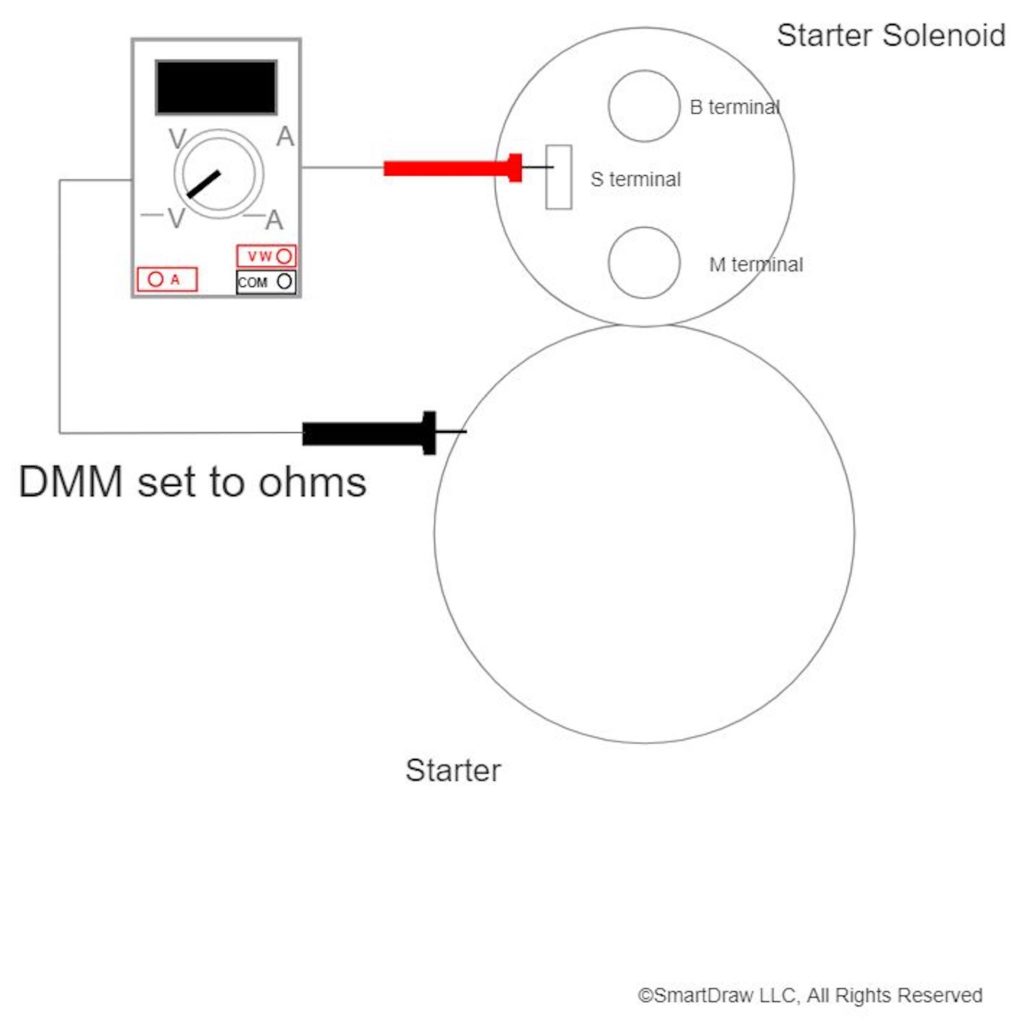Few problems can be as frustrating as a car that won’t start—especially when you’re in a rush to get to work. We’ve all been there at some point: You go to start your vehicle, but nothing happens. Is the starter sticking? The engine doesn’t crank or start—and you’re left trying to hitch a ride to work.
Could the problem be a bad solenoid on your starter? It could also be that your car won’t start unless I jump the solenoid. What causes a starter solenoid to go bad? Read on to find out what symptoms to watch out for, which issues could mimic a bad starter solenoid, and how to tell whether the starter solenoid is indeed the culprit.

5 Causes of a Bad Starter Solenoid
Solenoid issues can be caused by the following:
Wear and tear
After many years of use, some starter solenoids can wear out. If so, they must be replaced in order for your vehicle to start properly.
Contactor Part Issues
A very common issue with solenoids is failure of the contactor part of the solenoid that carries the load from the battery connection to the starter motor. Sometimes the contacts will simply develop resistance and voltage will be lost there, so that the starter motor only gets a fraction of the voltage needed to spin the engine.
Also, if current is being lost between the ignition switch or at the neutral safety switch so that the solenoid doesn’t get enough voltage to “snap” the contactor closed in the solenoid, the contacts and the starter will both be damaged. Repeat starter failures sometimes happen due to lost voltage on the primary side of the solenoid circuit that comes from the ignition switch. This is rare, but it has happened.
Heat
Heat can melt the insulation on the wires of a starter solenoid or cause an electrical short. Note, however, that if the wires are overheating, there’s typically a reason for it. So the real cause must be investigated.
Heat can also cause the moving parts inside the solenoid to contract or expand. This can stop the plunger from making a good connection with the battery terminal or hinder the solenoid from engaging the starter motor.
Overtightened Bolts
Overtightening the bolts can also distort the shape of the housing, which can damage the internal components, causing the starter solenoid to fail and preventing the engine from starting.
Pro Tip: The phenolic part of the starter solenoid is easily broken when tightening the bolts.
4 Signs of a Bad Starter Solenoid


Before we get into the symptoms of a bad starter solenoid, let’s discuss what this part does and how it works.
Although you may have heard of a starter solenoid, you might not know what the part actually does. Basically, the starter solenoid is an electromechanical device that engages the starter motor. Most starter solenoids are mounted directly on top of the starter.
When you start your car, electrical current from the battery travels through the starting circuit (relay, etc.) to the starter solenoid. When energized, a set of windings inside the solenoid force a plunger and shift fork to engage the starter motor’s drive assembly.
At the same time, the plunger pushes a disc against a set of contacts, allowing current to flow through the solenoid to the starter. As a result, the starter drive assembly cranks the engine to get it going.
After reading the description above, you can probably surmise that a faulty starter solenoid can prevent the starter from operating. And that can keep your car’s engine from starting.
As a result, the common signs of a bad starter solenoid include:
Engine Doesn’t Crank or Start
When the starter solenoid decides to call it quits, the starter motor won’t work, either. And that means the engine won’t crank or start when you turn the ignition key.
No Clicking Noise When Trying to Start the Engine
That clicking noise you hear when you go to start your car (but nothing happens) is either the starter solenoid or the starter relay. So, if you don’t hear anything—not even a click—when trying to start your car, you may be dealing with a bad starter solenoid.
Starter Spins Without Fully Engaging the Flywheel (Rare)
Although rare, a weak solenoid can allow the starter to spin without engaging the engine’s flywheel or flexplate. In such a scenario, you’ll hear the starter spinning, but the engine won’t crank.
Engine Cranks Slowly (Rare)
It’s possible for high resistance in the starter solenoid to cause the contacts to burn. As a result, there will be excessive resistance in the starter motor, potentially resulting in an engine that cranks slowly. Once again, this scenario is rather uncommon.
Common Problems That Can Mimic a Bad Starter Solenoid
Several problems can mimic a bad starter solenoid or starter motor. The most common include:
- Dead battery
- Loose or corroded battery terminals/cables
- Issues with the starting circuit
- Seized engine
You can learn more by reading this article: Car Won’t Start and There’s a Clicking Noise.
How to Tell if a Starter Solenoid is Bad
Caution: Always wear safety glasses.
Testing a starter solenoid is usually fairly straightforward.
Note: The following are general guidelines for educational and entertainment purposes only. Consult your vehicle’s factory information for specific repair instructions and recommended safety procedures
1. Always test the battery first
Whenever an engine doesn’t crank (or it sluggishly tries to turn over), you want to begin your troubleshooting process at the battery. You can find out how to test a battery by reading this article: How to Test a Car Battery With a Multimeter.
2. Check That Power is Getting to the Starter Solenoid
Once you know that the battery is good, you’ll want to check whether power is getting to the starter solenoid. If there’s an issue somewhere in the starting circuit, power won’t reach the solenoid, resulting in a vehicle that doesn’t crank or start.
You can learn how to test the starting circuit by reading the applicable section in this article: 5 Signs of a Bad Starter.
3. Test the Starter Solenoid Itself
If you find that power is indeed getting to the starter solenoid, the next step is to test the solenoid itself.
Many repair manuals recommend checking the starter solenoid for internal continuity if the vehicle doesn’t crank. To perform this test, you’ll need a digital multimeter (DMM). Here’s how it’s done:

- Put on your safety glasses.
- Make sure the vehicle’s ignition switch is turned to the OFF position.
- Set your digital multimeter (DMM) to the ohms setting.
- Disconnect the starter cable from the solenoid’s ‘M’ terminal (the terminal that attaches to the cable going to the starter motor).
- Connect one meter lead to the solenoid’s ‘S’ terminal (the terminal that receives power from the ignition switch).
- Connect the other meter lead to the solenoid’s ‘M’ terminal.
- If your meter reads out of limits (OL), the solenoid is faulty and should be replaced.

- Next, connect one meter lead to the solenoid’s ‘S’ terminal.
- Connect the other meter lead to ground on the starter motor’s case.
- If your meter reads out of limits (OL), the solenoid is faulty and should be replaced.
You can also bench test both the starter solenoid and the starter motor. Remember: These days, the starter solenoid and starter motor usually come together as a single assembly. That means you may need to replace both if you find the solenoid is bad.
The video below demonstrates bench testing the starter and starter solenoid:
You can also check out this video to know more about how a starter works:
If you determine both the starter and solenoid are good during testing, you’ll want to check whether the engine is seized. You can do this by attaching a breaker bar to the crankshaft pulley bolt, then trying to turn the engine over by hand. An engine that doesn’t budge is seized.
Starter Solenoid Voltage Drop Tips
If voltage across the starter contacts is measured while the starter is spinning and the meter reads more than .5 volts, voltage is being “dropped” through the starter solenoid due to scorched contacts. This is a “voltage drop test,” which is very commonly used for this purpose and others by professionals.

Pro Tip: When in doubt, bench test the starter by removing it and placing it on the ground or a workbench. Use a known good battery and a set of jumper cables to test the starter.
With the ground cable clamp connected to the starter body and the positive cable clamp connected to the upper post (battery post) on the starter, jumper the voltage to the small (primary) solenoid wire to energize the solenoid. Hold the starter very tightly (or have it in a vise) when you do this because a good starter will spin very suddenly and with a lot of force. Keep your fingers away from the starter drive while doing this.
If the starter spins slowly during the bench test, replace the entire starter. If the solenoid clicks but the starter doesn’t spin, connect the positive cable to the large lower post leading directly to the starter motor. If it spins rapidly when you do this but won’t spin when the solenoid is engaged by applying voltage to the small terminal, the solenoid is bad.
Pro Tip: It’s usually more cost-effective to replace the whole starter.
How Much Does it Cost to Replace a Bad Starter Solenoid?
The starter motor and starter solenoid are usually serviced together as a single assembly. On average, you can expect to pay between $400 and $600 to have a professional replace the starter on your vehicle.
Any information provided on this Website is for informational purposes only and is not intended to replace consultation with a professional mechanic. The accuracy and timeliness of the information may change from the time of publication.


















